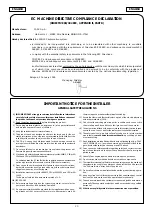
7251 / 7351 Slide Gate Operator
INSTALLATION AND PROGRAMMING MANUAL
8
www.hysecurity.com • 800-321-9947
MX4514 Rev. A ©2019
CONTACT SENSORS (EDGE)
For a gate operator utilizing a contact sensor (Edge):
• One or more contact sensors shall be located where
entrapment or obstruction risks exists, such as at the
leading edge, trailing edge, and post mounted both
inside and outside of a vehicular horizontal slide gate.
• A hardwired contact sensor shall be located and its wiring
arranged so that the communication between the sensor
and the gate operator is not subjected to mechanical
damage.
• A wireless device such as one that transmits radio frequency
(RF) signals to the gate operator for entrapment protection
functions shall be located where the transmission of
the signals are not obstructed or impeded by building
structures, natural landscaping or similar obstruction. A
wireless device shall function under the intended end-use
conditions.
• One or more contact sensors shall be located on the inside
and outside leading edge of a swing gate. Additionally, if
the bottom edge of a swing gate is greater than 152 mm
(6 in) but less than 406 mm (16 in) above the ground at
any point in its arc of travel, one or more contact sensors
shall be located on the bottom edge.
USE OF VEHICLE DETECTORS
Use of vehicle detectors (loop detectors) is strongly
encouraged to prevent damage to vehicles caused by gates
closing on them. This is not considered to be a safety item as
vehicle detectors cannot provide protection to pedestrians.
In some situations, photoelectric devices may be used as
vehicle detectors, but should be wired accordingly.
GATE CONSTRUCTION & SAFETY
Gate construction plays a very important role in ensuring the
safety of any automated gate system. The standard for gate
construction is ASTM F2200. Below are key areas to address
safety in gate design. For complete information consult the
standard. Copies of the standard are available at:
https://www.astm.org/Standards/F2200.htm
Another source of information is available from DASMA, the
Door and Access System Manufacturer’s Association. The
Association publishes Technical Data Sheets, one of which
concerns ASTM F2200. For more information, see:
h t t p : / / w w w. d a s m a . c o m / P D F / P u b l i c a t i o n s /
TechDataSheets/OperatorElectronics/TDS370.pdf
GENERAL GATE CONSTRUCTION REQUIREMENTS:
G
ate
t
ypes
Gates shall be constructed in accordance with the provisions
given for the appropriate gate type listed. Refer to ASTM
F2200 for additional gate types.
D
etacheD
G
ates
Gates shall be designed, constructed and installed to not fall
over more than 45 degrees from the vertical plane, when a gate
is detached from the supporting hardware.
G
ate
B
ottom
e
DGe
Gates shall have smooth bottom edges, with vertical bottom
edged protrusions not exceeding 0.50 inch (12.7 mm) when
other than the exceptions listed ASTM F2200.
B
arBeD
W
ire
/t
ape
h
eiGht
The minimum height for barbed wire shall not be less than 6
ft. (1.83 m) above grade. The minimum height for barbed tape
shall not be less than 8 ft. (2.44 m) above grade.
e
xistinG
G
ate
L
atches
An existing gate latch shall be disabled when a manually
operated gate is retrofitted.
G
ate
L
atch
r
estrictions
A gate latch is not allowed on an automatically operated gate.
G
ate
p
rotrusions
Protrusions shall not be permitted on any gate. Consult ASTM
F2200 for exceptions.
G
ravity
anD
G
ate
m
ovement
Gates shall be designed, constructed and installed such that
their movement shall not be initiated by gravity when an
automatic operator is disconnected.
p
eDestrian
G
ates
For pedestrian access in the vicinity of an automated vehicular
gate, a separate pedestrian gate shall be provided. The
pedestrian gate shall be installed in a location such that a
pedestrian shall not come in contact with a moving vehicular
access gate. A pedestrian gate shall not be incorporated into
an automated vehicular gate panel.
u
pGraDinG
n
on
-a
utomatic
Gates
Any non-automated gate that is to be automated shall be
upgraded to conform to the provisions of this specification.
p
eDestrian
anD
non
-a
utomatic
G
ates
This specification shall not apply to gates generally used for
pedestrian access and to vehicular gates not to be automated.
u
pGraDinG
e
xistinG
a
utomateD
G
ates
Any existing automated gate, when the operator requires
replacement, shall be upgraded to conform to the provisions
of this specification in effect at that time.
VEHICULAR HORIZONTAL SLIDE GATE REQUIREMENTS:
c
Lass
i, ii
anD
iii v
ehicuLar
h
orizontaL
s
LiDe
G
ates
:
The following provisions shall apply to Class I, Class II and Class
III vehicular horizontal slide gates:









































